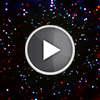CXC Home | Search | Help | Image Use Policy | Latest Images | Privacy | Accessibility | Glossary | Q&A
Tour of Chandra Deep Field South
Quicktime MPEG With closed-captions (at YouTube)
What happens when astronomers use Chandra to take a long look at the same patch of sky? That's the question the project known as the Chandra Deep Field-South is designed to answer. Since Chandra was launched in 1999, the telescope has repeatedly observed the same region. Today, the observing time spent looking at this region totals over 7 million seconds. That's more than 81 days!
There are many things that astronomers can learn by using Chandra to make this ultra-deep X-ray image. Perhaps first among them is what is happening with black holes in the early Universe. For example, the latest Deep Field image lets astronomers explore ideas about how supermassive black holes grew about one to two billion years after the Big Bang. Using these data, researchers showed that these black holes in the early Universe grow mostly in bursts, rather than via the slow accumulation of matter.
The researchers also detected X-rays from massive galaxies at distances up to about 12.5 billion light years from Earth. Most of the X-ray emission from the most distant galaxies likely comes from large collections of stellar-mass black holes within the galaxies. These black holes are formed from the collapse of massive stars and typically weigh a few to a few dozen times the mass of the Sun.
By combining the Chandra Deep Field with observations from other telescopes including Hubble, scientists can continue to probe some of the most important questions in astrophysics.
[Runtime: 02:29]
Quicktime MPEG With closed-captions (at YouTube)
What happens when astronomers use Chandra to take a long look at the same patch of sky? That's the question the project known as the Chandra Deep Field-South is designed to answer. Since Chandra was launched in 1999, the telescope has repeatedly observed the same region. Today, the observing time spent looking at this region totals over 7 million seconds. That's more than 81 days!
There are many things that astronomers can learn by using Chandra to make this ultra-deep X-ray image. Perhaps first among them is what is happening with black holes in the early Universe. For example, the latest Deep Field image lets astronomers explore ideas about how supermassive black holes grew about one to two billion years after the Big Bang. Using these data, researchers showed that these black holes in the early Universe grow mostly in bursts, rather than via the slow accumulation of matter.
The researchers also detected X-rays from massive galaxies at distances up to about 12.5 billion light years from Earth. Most of the X-ray emission from the most distant galaxies likely comes from large collections of stellar-mass black holes within the galaxies. These black holes are formed from the collapse of massive stars and typically weigh a few to a few dozen times the mass of the Sun.
By combining the Chandra Deep Field with observations from other telescopes including Hubble, scientists can continue to probe some of the most important questions in astrophysics.
[Runtime: 02:29]
(Credit: X-ray: NASA/CXC/Penn State/B.Luo et al. Optical: NASA/Hubble )
Return to Chandra Deep Field South (January 5, 2017)



